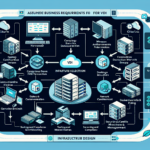Configuring load balancers for web applications is critical for ensuring high availability, scalability, and performance. Here’s a step-by-step guide to configure load balancers effectively:
1. Define Your Load Balancing Strategy
Decide on the load-balancing method based on the requirements of your web application:
– Round Robin: Distributes requests sequentially across servers.
– Least Connections: Routes traffic to the server with the fewest active connections.
– IP Hash: Routes traffic based on a hash of the client’s IP address.
– Weighted Distribution: Assigns weights to servers based on their capacity.
2. Choose a Load Balancer Type
- Hardware Load Balancer: Dedicated appliances for high-performance environments.
- Software Load Balancer: Software-based solutions like HAProxy, NGINX, or Apache Traffic Server.
- Cloud Load Balancer: Managed services like AWS Elastic Load Balancer (ELB), Azure Load Balancer, or Google Cloud Load Balancer.
3. Provision the Load Balancer
- On-Premise: Deploy and configure hardware/software load balancers within your datacenter.
- Cloud: Use your cloud provider’s native load balancer service.
4. Configure the Backend Server Pool
Define the servers that the load balancer will distribute traffic to:
– Add Backend Servers: Specify the IP addresses or FQDNs of your web servers.
– Health Checks: Configure periodic health checks to ensure servers are operational. Common checks include HTTP(S) status codes, response times, or TCP connectivity.
5. Set Up the Frontend Configuration
- Listener Configuration: Define how the load balancer listens for incoming traffic. Specify the protocol (HTTP, HTTPS, TCP) and port.
- SSL/TLS Configuration: If using HTTPS, configure SSL certificates on the load balancer for encrypted communication. Use Let’s Encrypt or import custom certificates.
6. Configure Session Persistence (Optional)
- If your application requires sticky sessions (e.g., for user authentication or shopping carts), enable session persistence. This can be done via cookies or IP-based persistence.
7. Configure DNS
- Point your domain name to the load balancer’s public IP or DNS name.
- Use a global DNS service like AWS Route 53 or Cloudflare to manage traffic across regions if you have multi-region deployments.
8. Enable Autoscaling (For Cloud Environments)
If using a cloud provider, integrate the load balancer with an autoscaling group to automatically add or remove servers based on traffic patterns.
9. Optimize and Monitor Performance
- Logging: Enable logging to track traffic and errors.
- Monitoring: Use monitoring tools like Prometheus, Grafana, or cloud-native solutions (CloudWatch, Azure Monitor) to monitor load balancer performance.
- Testing: Perform load testing using tools like Apache JMeter, Locust, or k6 to ensure the configuration can handle expected traffic.
10. Security Considerations
- Firewall Rules: Restrict access to only necessary ports (e.g., 80, 443).
- DDoS Protection: Use tools like AWS Shield, Cloudflare DDoS Protection, or Azure DDoS Protection.
- WAF (Web Application Firewall): Configure a WAF to protect against common web threats like SQL injection or cross-site scripting.
11. High Availability
- Failover: Deploy multiple load balancers in active-passive or active-active mode.
- Redundancy: Use multiple availability zones or regions to avoid single points of failure.
Example Configurations:
Using NGINX as a Load Balancer
“`nginx
http {
upstream backend {
server server1.example.com;
server server2.example.com;
}
server {
listen 80;
location / {
proxy_pass http://backend;
proxy_set_header Host $host;
proxy_set_header X-Real-IP $remote_addr;
proxy_set_header X-Forwarded-For $proxy_add_x_forwarded_for;
}
}
}
“`
Using AWS Elastic Load Balancer
- Create an Application Load Balancer (ALB).
- Configure target groups and register EC2 instances.
- Set health checks for the target group.
- Configure listeners for HTTP/HTTPS traffic.
- Update Route 53 DNS settings to point to the ALB.
By implementing these steps, you’ll ensure your load balancer is configured to optimize web application performance, reliability, and scalability. Let me know if you need a specific configuration example or further assistance!


